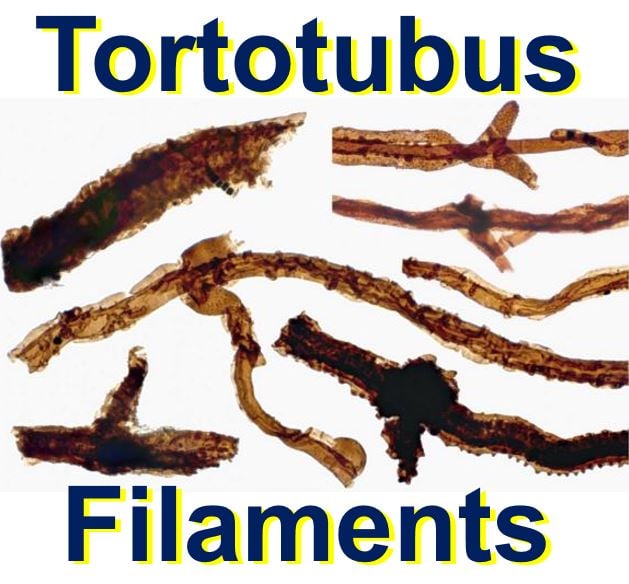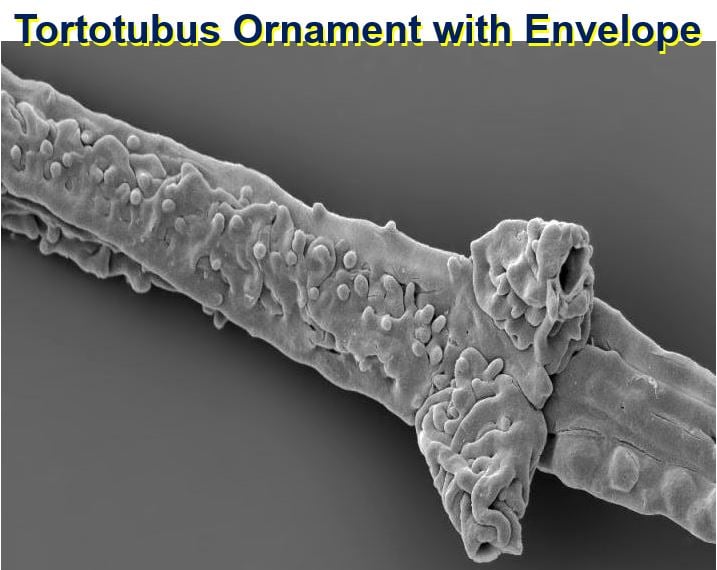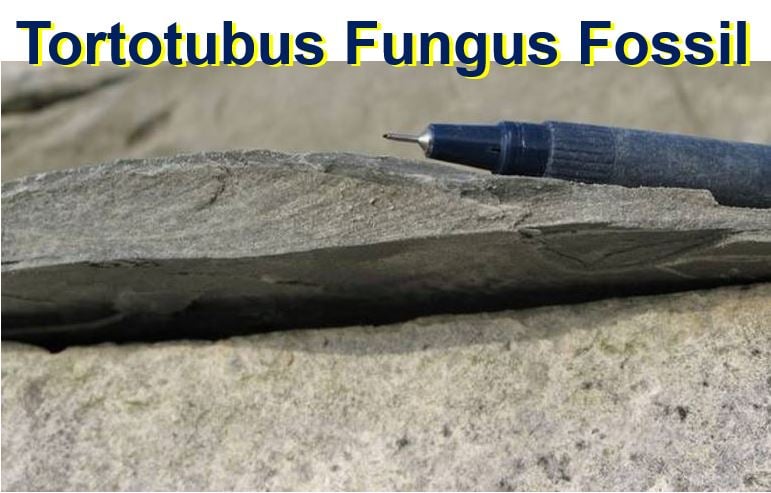We originated from super-ancient fungi 440 million years ago, says a scientist, who claims he has identified the earliest example of an organism that lived on land. This ancient fungus probably kick-started the process of rot and soil formation, which triggered the later growth and diversification of fauna and flora on land, including humans.
A researcher from the University of Cambridge in England says that a 440-million-year-old fossil is not only the oldest example of a fossilised fungus, but is also the earliest fossil of any organism that lives on land that we know about.
The organism, and other similar ones at the time, played a major role in laying the groundwork for more complex life forms, initially plants and then animals, to exist on land by kick-starting the process of rot and soil formation, which is crucial for all land-based life.
 Three filaments of Tortotubus from Gotland in Sweden, showing growth of secondary branches along main filament. Transmitted Light Micrograph. (Image: University of Cambridge. Credit: Martin R. Smith)
Three filaments of Tortotubus from Gotland in Sweden, showing growth of secondary branches along main filament. Transmitted Light Micrograph. (Image: University of Cambridge. Credit: Martin R. Smith)
Tortotubus started it all
This early land based organism, called Tortotubus, had a structure that is similar to those of some modern fungi, which probably enabled it to store and transport nutrients through the process of decomposition.
Dr. Martin Smith wrote in the Botanical Journal of the Linnean Society (citation below) that we cannot be 100% sure it was the first organism to have existed on land – there might have been others before it. We can say it is the oldest fossil of a terrestrial organism ever found, i.e. it is the oldest one we know about.
Dr. Smith, who is today based at Durham University but worked at the University of Cambridge’s Department of Earth Sciences when he was conducting the study, said:
“During the period when this organism existed, life was almost entirely restricted to the oceans: nothing more complex than simple mossy and lichen-like plants had yet evolved on the land. But before there could be flowering plants or trees, or the animals that depend on them, the processes of rot and soil formation needed to be established.”
 Filament of Tortotubus showing envelope of secondary filaments covering main filament and primary branches, and developing a distinctive pustular ornament. Scanning Electron Micrograph. (Image: eurekalert.org. Credit: Martin R. Smith)
Filament of Tortotubus showing envelope of secondary filaments covering main filament and primary branches, and developing a distinctive pustular ornament. Scanning Electron Micrograph. (Image: eurekalert.org. Credit: Martin R. Smith)
Study involved working with ultra-tiny fossils
Working with several microfossils from Scotland and Sweden, each one shorter that the width of a human hair, Dr. Smith tried to reconstruct the method of growth for two different kinds of fossils that were first identified in the 1980s.
Scientists had thought the fossils represented parts of two different organisms. By identifying other fossils with ‘in-between’ forms, Dr. Smith was able to demonstrate that, in fact, the fossils represented parts of a single organism at various stages of growth.
By reconstructing the organism’s growth, he was able to show that the fossils represent mycelium – the vegetative parts of a fungus, consisting of a network of root-like white filaments (hyphae).
Pinpointing exactly when life first moved from the seas to the land is very difficult, since the useful features in the fossil record that could help us identify the earliest land colonisers are extremely rare. Most scientists generally agreed that the migration started early in the Palaeozoic era – from 500 to 450 million years ago.
However, there had to be nutrients on the land before any complex forms of life could live on land.
 A tortotubus fungus fossil. If it weren’t for these fungi, we would probably not exist. (Image: University of Cambridge)
A tortotubus fungus fossil. If it weren’t for these fungi, we would probably not exist. (Image: University of Cambridge)
First soils emerged thanks to fungi
Fungi played a major role in the shift from sea to land, since by kick-starting the decomposition process, a layer of fertile soil could eventually be built up, enabling plants with roots to establish themselves, which in turn became the food to support animal life.
Fungi play a crucial role in the nitrogen cycle, in which nitrates in the soil are absorbed by the plant roots and passed along the food chain to animals.
Rotting fungi convert nitrogen-containing compounds and animal and plant waste and remains back into nitrates, which are incorporated into the earth and can again be taken up by plants.
These ancient fungi began the process of getting oxygen and nitrogen into the soil.
 Author of the paper, Dr. Martin Smith, is Lecturer in Palaeontology in the Department of Earth Sciences at Durham University. At the time of the study he was at the University of Cambridge. (Image: Durham University)
Author of the paper, Dr. Martin Smith, is Lecturer in Palaeontology in the Department of Earth Sciences at Durham University. At the time of the study he was at the University of Cambridge. (Image: Durham University)
Dr. Smith found that Tortotubus had a cord-like structure, like some modern fungi do, in which the main filament sends out primary and secondary branches that stick back onto the main filament, eventually enveloping it completely.
This cord-like structure is commonly seen in terrestrial organisms, allowing them to spread out and colonise surfaces. In fungi today, the structure is associated with the decomposition of matter, allowing a colony of fungi to move nutrients to where they are needed – a useful adaptation in places where nutrients are scarce and distributed unevenly.
In contrast with early plant life, which lacked roots and therefore had limited interaction with activity below the surface, fungi played a key role in stabilizing sediment, encouraging weathering and forming fertile soils.
Early fungi kick-started process of rotting on land
Dr. Smith said:
“What we see in this fossil is complex fungal ‘behaviour’ in some of the earliest terrestrial ecosystems – contributing to soil formation and kick-starting the process of rotting on land.”
A question is: If Tortotubus was the first one on land, what was there for it to decompose? Dr. Smith believes there were probably algae or bacteria on land during this period, but these types of organisms are very rarely found in fossils.
Dr. Smith said:
“This fossil provides a hint that mushroom-forming fungi may have colonised the land before the first animals left the oceans,” said Smith. “It fills an important gap in the evolution of life on land.”
In an Abstract in the journal, Dr. Smith wrote:
“The presence of complex mycelial fossils in the earliest Silurian corroborates the likely contribution of fungi to the colonization of land and the establishment of modern sedimentological systems; their rise seemingly accompanied the diversification of early embryophytes and the vegetation of the terrestrial biosphere.”
The study was supported by Clare College, Cambridge.
Citation: ‘Cord-forming Palaeozoic fungi in terrestrial assemblages,’ Martin R. Smith. Botanical Journal of the Linnean Society 180 (2016). 2 March 2016. DOI: 10.1111/boj.12389.

